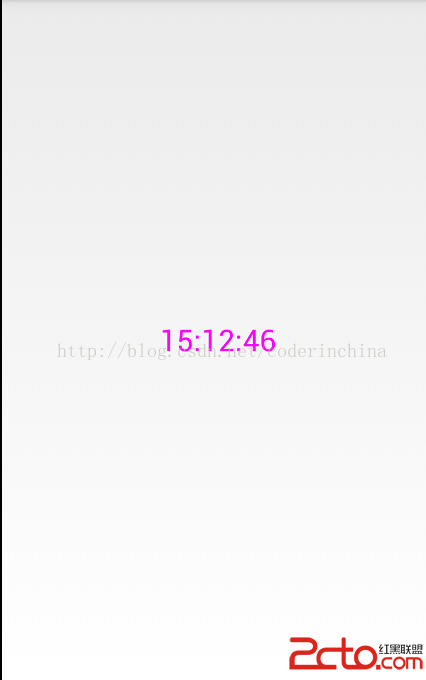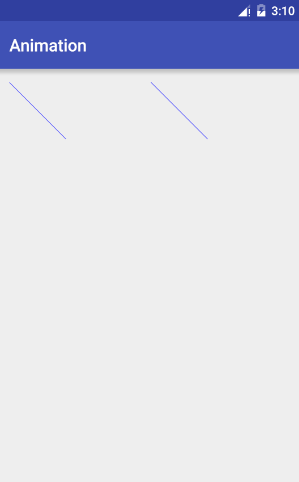編輯:關於Android編程
在android如果表示數字時針一般用DigitalClock,這個類是google給我們開發者提供的一個方便的類實現數字時針的功能,現在就寫個demo,為什麼要講這個類呢?因為我下篇要講ListView item倒計時功能,所以先把這個基礎練習一下,以及它的實現方式,新建android項目digitalClockdemo
布局activity_main.xml文件

這個數字是變化的 這只是靜態圖,為什麼代碼沒寫會出來這個效果,所以就得看下他的源碼了
public class DigitalClock extends TextView {
Calendar mCalendar;
private final static String m12 = h:mm:ss aa;
private final static String m24 = k:mm:ss;
private FormatChangeObserver mFormatChangeObserver;
private Runnable mTicker;
private Handler mHandler;
private boolean mTickerStopped = false;
String mFormat;
public DigitalClock(Context context) {
super(context);
initClock(context);
}
public DigitalClock(Context context, AttributeSet attrs) {
super(context, attrs);
initClock(context);
}
private void initClock(Context context) {
Resources r = mContext.getResources();
if (mCalendar == null) {
mCalendar = Calendar.getInstance();
}
mFormatChangeObserver = new FormatChangeObserver();
getContext().getContentResolver().registerContentObserver(
Settings.System.CONTENT_URI, true, mFormatChangeObserver);
setFormat();
}
@Override
protected void onAttachedToWindow() {
mTickerStopped = false;
super.onAttachedToWindow();
mHandler = new Handler();
/**
* requests a tick on the next hard-second boundary
*/
mTicker = new Runnable() {
public void run() {
if (mTickerStopped) return;
mCalendar.setTimeInMillis(System.currentTimeMillis());
setText(DateFormat.format(mFormat, mCalendar));
invalidate();
long now = SystemClock.uptimeMillis();
long next = now + (1000 - now % 1000);
mHandler.postAtTime(mTicker, next);
}
};
mTicker.run();
}
@Override
protected void onDetachedFromWindow() {
super.onDetachedFromWindow();
mTickerStopped = true;
}
/**
* Pulls 12/24 mode from system settings
*/
private boolean get24HourMode() {
return android.text.format.DateFormat.is24HourFormat(getContext());
}
private void setFormat() {
if (get24HourMode()) {
mFormat = m24;
} else {
mFormat = m12;
}
}
private class FormatChangeObserver extends ContentObserver {
public FormatChangeObserver() {
super(new Handler());
}
@Override
public void onChange(boolean selfChange) {
setFormat();
}
}
}
首先知道了DigitalClock類是繼承此TextView
從構造函數中開始看initClock()方法,代碼如下
private void initClock(Context context) {
Resources r = mContext.getResources();
if (mCalendar == null) {
mCalendar = Calendar.getInstance();
}www.2cto.com
mFormatChangeObserver = new FormatChangeObserver();
getContext().getContentResolver().registerContentObserver(
Settings.System.CONTENT_URI, true, mFormatChangeObserver);
setFormat();
}
setFormat()方法默認是顯示24小時的,最主要的是onAttachedToWindow()方法,
onAttachedToWindow()是掛載在窗體上的 他在activity的onResume()方法之後會執行,
在onAttachedToWindow()方法中關鍵是這段代碼:
mHandler = new Handler();
/**
* requests a tick on the next hard-second boundary
*/
mTicker = new Runnable() {
public void run() {
if (mTickerStopped) return;
mCalendar.setTimeInMillis(System.currentTimeMillis());
setText(DateFormat.format(mFormat, mCalendar));
invalidate();
long now = SystemClock.uptimeMillis();
long next = now + (1000 - now % 1000);
mHandler.postAtTime(mTicker, next);
}
};
mTicker.run();
這是整個類的核心,
mCalendar.setTimeInMillis(System.currentTimeMillis());
setText(DateFormat.format(mFormat, mCalendar));
這二行代碼就是顯示在我們桌面上的時間 DigitalClock在內部已經實現了,所以為什麼我們不用寫代碼就看到數字時針時間了,
invalidate();沒時間變化一次 就會重新繪制UI
long now = SystemClock.uptimeMillis();//從開機到現在的毫秒數(手機睡眠的時間不包括在內);
long next = now + (1000 - now % 1000);
mHandler.postAtTime(mTicker, next);
long next = now + (1000 - now % 1000);這行代碼表示沒看懂?
 android Path 和 PathMeasure 進階
android Path 和 PathMeasure 進階
1 概述在前面的《路徑和文字》中,講解了path的基本用法,這裡講解一些上篇沒有講到的東西。2 Path 這裡講解path相關的方法,後面繼續講解PathMeasure,
 Android必知必會-帶列表的地圖POI周邊搜索
Android必知必會-帶列表的地圖POI周邊搜索
背景先看效果圖:(以公司附近的國貿為中心點)上面是地圖,下面是地理位置列表,有的只有地理位置列表(QQ動態的位置),這是個很常見的功能。它有個專門的叫法:POI周邊搜索。
 android MediaPlayer
android MediaPlayer
Playback control of audio/video files and streams is managed as a state machine. The
 android sqlite另類用法(對象存取)
android sqlite另類用法(對象存取)
在andorid端使用sqlite數據庫是經常的事,通常來說都是對每個屬性對應一個字段,然後分字段的來讀取,但是今天我要說的不是這樣的。我們通過對象序列化來存取。因為一個